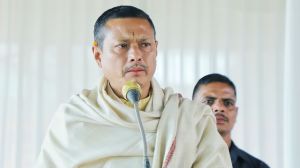Now world can browse through Ramanujan’s Lost Notebook, 29 years after its discovery
Twenty-nine years after an American mathematician pottering around the Trinity College Library (UK) stumbled upon hundreds of forgotten form...

Twenty-nine years after an American mathematician pottering around the Trinity College Library (UK) stumbled upon hundreds of forgotten formulas scribbled by math genius Srinivasa Ramanujan in his last years, their secrets are on the verge of being revealed with pathbreaking and complete answers.
The formulas were noted by a dying, bed-ridden Ramanujan a year or two before his untimely death aged 32, at Chennai in 1920.
In 1976 these pages shot to fame as Ramanujan’s invaluable Lost Notebook that quickly became contemporary mathematics’ great riddle.
Mathematics duo George Andrews—he found the notebook—and Bruce Berndt have spent years solving Ramanujan’s last enigmas. Written over 85 years ago, they still point to questions of current interest.
‘‘This manuscript took me by complete surprise,’’ Andrews, faculty at Pennsylvania State University, told The Sunday Express.
The first edited volume, with 442 entries of the Lost Notebook and some unpublished papers, will be published within a couple of months.
‘‘Unfortunately, Ramanujan wrote these formulas without any explanatory comments,’’ says Andrews. ‘‘Some proofs are very difficult and unilluminating. There was never a moment when I did not wish that Ramanujan was around to explain himself.’’
The authors—world experts on Ramanujan—are now writing volume two. But volume three will be the ‘‘hardest’’ says Andrews, with the hope of finishing. ‘‘In a few years.’’
Questioned on the significance of the forthcoming volume, Andrews replies that ‘‘most everything is new. There are some results that were rediscovered between 1920 and 1976, but not a large percentage. There have been many research articles on the Lost Notebook, but this is the first complete account.’’
Bruce Berndt (65) a distinguished research professor at the University of Illinois mathematics department joined this project during the late nineties, working exclusively on it since summer 2003.
|
In Retrospect
|
||
|
• Among history’s greatest mathematicians, Srinivasa Ramanujan was born 1887, to a Brahmin family at Kumbakonam, Tamil Nadu. |
||
Sometimes he struggled with the feverish handwriting. ‘‘His writing is clear, but on some pages it runs at all angles,’’ sighs Berndt. ‘‘Some entries are cryptic or incomplete. Some scratchwork we will likely never figure out. But less than 10 per cent formulas are yet to be proved.’’
Berndt emphasises that Ramanujan was not ‘‘old-fashioned’’. Mathematical research, though largely theoretical, underpins applications from aircraft design to computer science and nuclear physics.
In the past months Berndt and colleague Alexandru Zaharescu proved a formula from the Lost Notebook that has connections with the ‘‘deepest and famous’’ unsolved problems in number theory—the circle problem and the divisor problem.
‘‘This formula is one of a pair on one page of the notebook,’’ says Berndt, confessing he always wished he could ask Ramanujan his motivations. ‘‘At this moment, we cannot prove the second formula!’’
The original Lost Notebook is at the Trinity College Library, Cambridge. ‘‘I have turned to it again and again for inspiration,’’ recalls Andrews, ‘‘always coming upon new challenges that had escaped my notice. It played a major role in most of my work.’’
Andrews, Berndt and his students have ‘‘pretty much proved’’ all of Ramanujan’s assertions. ‘‘Some entries are routine for experts but many point to questions of current interest,’’ says Andrews. ‘‘A lot still needs to be don.’’
Four number theorists at the University of Florida’s mathematics department— including the department chairman Krishnaswami Alladi—work in areas influenced by Ramanujan. ‘‘The Lost Notebook is very much our interest,’’ Alladi says.
‘‘Edited versions of Ramanujan’s original notebooks by Berndt had tremendous impact, earning him the Steele Prize of the American Mathematical Society,’’ he adds. ‘‘We expect publication of edited versions of the Lost Notebook to have equally significant impact.’’
At Chennai’s Institute of Mathematical Sciences, director R Balasubramanian emphasises that Andrews and Berndt are putting Ramanujan’s work in the modern context. ‘‘It’s very important that the Lost Notebook is being edited and published.’’
But Andrews humbly concludes that the world would have been richer if Ramanujan had lived to explain his lost discoveries.



- 01
- 02
- 03
- 04
- 05




























